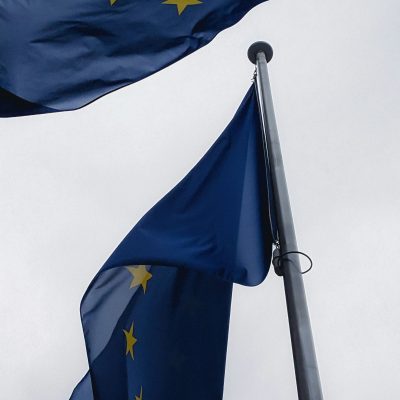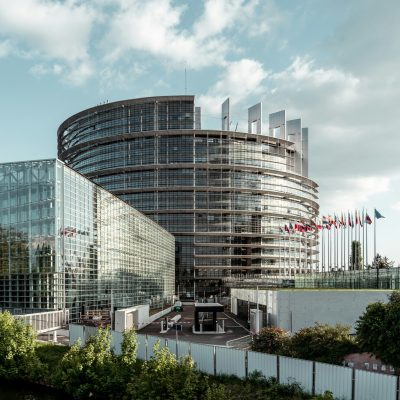Comment fonctionne la Conférence sur l’avenir de l’Europe?

Imaginée par le président français Emmanuel Macron dans sa « lettre aux Européens » publiée au cours de la campagne des élections européennes de mai 2019, cette Conférence est à l’origine pensée pour « proposer tous les changements nécessaires à notre projet politique, sans tabou, pas même la révision des traités », en particulier à partir de propositions citoyennes.
Un non paper est ensuite proposé par la France et l’Allemagne en novembre de la même année, appelant à l’organisation d’une Conférence sur l’avenir de l’Europe devant s’étaler sur 2 ans (du printemps 2020 au printemps 2022) et destinée à rediscuter toutes les facettes de l’Union européenne afin de la rendre « plus unie et souveraine ». Y seraient ainsi abordés pêle-mêle les thèmes du rôle de l’Europe dans le monde, des transitions climatique et numérique, des migrations, de l’État de droit et des thèmes institutionnels tels que les Spitzenkandidaten ou les listes transnationales.
Avec l’arrivée de la pandémie de Covid-19, le projet est mis de côté et ne débute pas, comme prévu initialement, le 9 mai 2020. C’est notamment sous la pression du Parlement européen que les discussions reprennent à l’automne en vue de définir la structure de gouvernance de cette Conférence. Les négociations sont particulièrement difficiles, et malgré un accord fin 2020 sur presque tous les éléments de la déclaration commune interinstitutionnelle fixant les priorités et les modalités de la Conférence, elles bloquent successivement sur la présidence de la Conférence, sur sa durée, ainsi que sur les prérogatives puis la composition de son assemblée plénière.
Après de longues discussions entre les trois institutions, un accord est finalement trouvé le 7 mai 2021 — l’avant-veille du lancement officiel de la Conférence à Strasbourg. Le règlement intérieur fixant la composition de la plénière et son mode de fonctionnement n’est approuvé par le conseil exécutif de la Conférence que le 9 mai.
1. La structure de gouvernance
Après avoir envisagé une présidence unique, occupée par une personnalité européenne forte et indépendante, les institutions de l’UE s’accordent sur une présidence conjointe, qui s’apparente plutôt à un patronage, réunissant les président(e)s du Parlement européen, de la Commission européenne et le chef d’État ou de gouvernement — selon le type de régime politique — de l’État membre assurant la présidence tournante du Conseil de l’UE.
Le pilotage politique des travaux de la Conférence est toutefois assuré au quotidien par le conseil (ou comité) exécutif, qui tranche par consensus toutes les questions liées à l’organisation de la Conférence, à la préparation des sessions plénières et à l’élaboration des rapports rendant compte de ces sessions. Il est composé des représentants des trois institutions (3 représentants et jusqu’à 4 observateurs chacune) qui en assurent également la coprésidence, de 5 observateurs provenant des parlements nationaux et d’un observateur pour chacune des entités suivantes : le Comité des régions, le Comité économique et social européen (CESE), BusinessEurope et la Confédération européenne des syndicats. Sa réunion constitutive s’est tenue le 24 mars 2021.
Ce conseil exécutif est assisté dans sa tâche par un secrétariat commun composé de façon égale des trois institutions avec 6 représentants chacune.
Les 3 représentant(e)s de la Commission au sein du conseil exécutif sont les vice-présidentes Dubravka Šuica, commissaire en charge de la Démocratie et de la Démographie (qui assure la coprésidence du conseil exécutif pour le compte de la Commission), et Věra Jourová, chargée des Valeurs et de la Transparence, ainsi que le vice-président Maroš Šefčovič, en charge des Relations interinstitutionnelles et de la Prospective.
Concernant les membres du Parlement européen faisant partie du conseil exécutif, les 3 représentants sont issus des 3 plus grands groupes politiques représentés au Parlement (Manfred Weber — PPE, Iratxe García Perez — S&D, et Guy Verhofstadt — Renew Europe, ce-dernier assurant la coprésidence du conseil exécutif pour le compte du Parlement), tandis que les 4 observateurs proviennent des 4 autres groupes présents au Parlement, par ordre décroissant d’eurodéputés : Gerolf Annemans (ID), Daniel Freund (Verts/ALE), Zdzisław Krasnodębski (CRE) et Helmut Scholz (La Gauche).
Les membres issus du Conseil sont les membres des gouvernements chargés des affaires européennes des 7 États membres assurant ou devant assurer successivement la présidence tournante du Conseil dans le futur. À l’heure actuelle — lesdits membres étant susceptibles d’être remplacés en cas de remaniement ou de changement de gouvernement —, les 3 représentants sont donc issus de la présidence portugaise en cours (Ana Paula Zacarias, qui assure la coprésidence du conseil exécutif pour le compte du Conseil) et des présidences slovène et française à venir (Gašper Dovžan et Clément Beaune), et les 4 observateurs des 4 présidences du Conseil de l’UE suivantes (dans l’ordre : Milena Hrdinková — République Tchèque, Hans Dahlgren — Suède, Juan González-Barba Pera — Espagne, et Sophie Wilmès — Belgique).
2. La participation citoyenne
Afin d’assurer une participation citoyenne la plus large possible, la Conférence repose sur une plateforme numérique multilingue innovante développée par la Commission. Celle-ci permet aux citoyens européens de proposer leurs propres idées, de se tenir informés des travaux de la Conférence mais également de réagir aux propositions déjà formulées, aussi bien dans les 24 langues officielles de l’UE que dans toutes les langues officielles de leur État. Les conclusions des événements organisés au niveau local dans le cadre de la Conférence sont aussi intégrées à la plateforme. Lancée le 19 avril, elle regroupe les propositions sous 10 familles thématiques : « Changement climatique et environnement », « Santé », « Une économie plus forte, justice sociale et emploi », « L’UE dans le monde », « Valeurs et droits, État de droit, sécurité », « Transformation numérique », « Démocratie européenne », « Migration » et « Éducation, culture, jeunesse et sport », ainsi qu’une rubrique « Autres idées ».
Les données récoltées sur la plateforme sont ensuite analysées grâce à l’intelligence artificielle par le Centre commun de recherche de la Commission, qui les transforme en rapports qualitatifs à destination des panels de citoyens et des sessions plénières de la Conférence.
Les panels de citoyens européens constituent l’échelon clé de la participation citoyenne et ont pour objectif de débattre des propositions formulées sur la plateforme et d’en réaliser une synthèse. Chacun de ces panels est composé de 200 citoyens, dont un tiers entre 16 et 25 ans, choisis de manière aléatoire tout en étant nécessairement représentatifs de la diversité de l’Union européenne en termes d’origine géographique et socioéconomique, d’âge, de niveau d’éducation et de genre.
Après, à nouveau, de nombreuses discussions, il a été décidé de réunir 4 de ces panels, qui se voient chacun assignés des thèmes précis : « Valeurs, droits, État de droit, démocratie, sécurité», « Changement climatique, environnement/santé », « Renforcement de l’économie, justice sociale, emploi/éducation, jeunesse, culture, sport/transition numérique » et « L’UE sur la scène internationale/migration ». Un mécanisme de suivi permettra ensuite aux citoyens de ces panels de présenter les résultats de leurs travaux à la plénière de la Conférence.
L’assemblée plénière de la Conférence, enfin, sera le lieu d’échanges structurés de manière thématique à partir des recommandations des panels de citoyens européens et nationaux et des contributions récoltées sur la plateforme numérique. « Équilibrée » en termes de genre, elle est composée de 433 membres dont 108 eurodéputés, 54 membres issus du Conseil (2 par État membre), 3 issus de la Commission, 108 représentants des parlements nationaux (4 par État membre), 108 citoyens (80 représentants des panels de citoyens européens, dont au moins un tiers de 16-25 ans, 27 représentants des panels nationaux de citoyens ou des événements de la Conférence — 1 par État membre — et le Président du Forum européen de la jeunesse), 18 représentants du Comité des régions, 18 représentants du CESE, 8 représentants des partenaires sociaux et 8 représentants de la société civile. Le Haut représentant de l’Union pour les affaires étrangères et la politique de sécurité sera invité lors des discussions portant sur le rôle de l’UE dans le monde.
3. Calendrier et suivi des travaux
Le lancement officiel de la Conférence s’est tenu le 9 mai 2021, jour de la Fête de l’Europe, au siège du Parlement européen à Strasbourg. À la suite de ce lancement, un premier événement destiné aux citoyens européens est organisé le 17 juin à Lisbonne, en tant que capitale de l’État membre qui occupe la présidence tournante du Conseil de l’UE au premier semestre 2021. Cet événement a pour objectif de réunir 27 représentants (1 par État membre) des panels nationaux de citoyens ou des événements organisés au niveau national, le président du Forum européen de la jeunesse et un certain nombre de citoyens déjà sélectionnés pour les panels de citoyens européens afin de débattre avec les trois coprésidents de leurs attentes.
Les panels de citoyens européens devraient se réunir à l’occasion de 3 sessions entre mi-septembre 2021 et mi-janvier 2022. L’assemblée plénière, elle, se réunit pour une session inaugurale les 18 et 19 juin à Strasbourg, dans le but, notamment, de présenter les panels de citoyens européens et la plateforme numérique multilingue. Elle devrait ensuite se réunir à 4 occasions au moins (22-23 octobre 2021, 17-18 décembre 2021, 21-22 janvier 2022, 18-19 février 2022).
Un événement final réunissant membres de l’assemblée plénière et participants aux panels de citoyens devrait a priori se tenir au mois d’avril 2022, pendant la présidence française du Conseil. La plénière transmettra ensuite ses propres propositions, arrêtées sur une base consensuelle (c’est-à-dire réunissant au moins le soutien de 4 piliers : les délégations issues du Parlement européen, de la Commission, du Conseil et des parlements nationaux), au conseil exécutif. Si une position clairement divergente de celle des citoyens était exprimée dans les propositions de l’assemblée plénière, cela devrait ressortir dans le rapport du conseil exécutif.
Ce dernier est en effet chargé de rédiger le rapport final de la Conférence. Il doit le faire à partir des propositions approuvées par la plénière, en pleine coopération avec celle-ci et en toute transparence. Ce rapport, approuvé par consensus et publié sur la plateforme numérique, sera finalement présenté aux 3 président(e)s de la Conférence. Il reviendra aux institutions qu’ils représentent d’examiner rapidement les préconisations du rapport et de décider du suivi des travaux.





